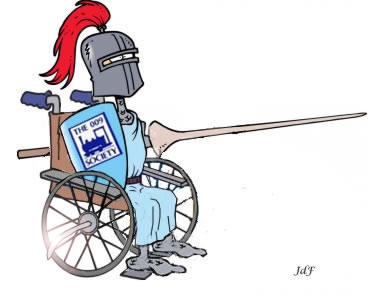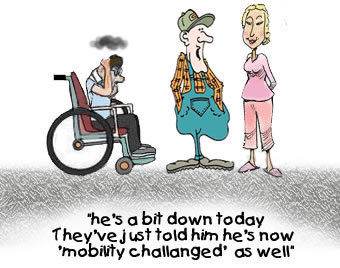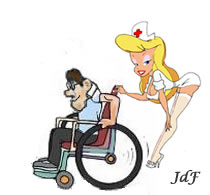|
Over some period of time I have made comments in
modelling forums concerning access for the disabled at model railway
exhibitions. Initially I made a few mild comments and have gradually become
more vocal. Why? Because often, this issue has been met with
a wall of abuse from some railway modellers. The article is, of course, one view and some people may have
alternative resolutions but I hope that at least it may present some of the
difficulties experienced at this time.

ready for a model rail exhibition
I have heard on several occasions that disabled
access is a 'contentious issue' in the model railway world. Indeed, when I
have criticised an exhibition because of its bad access, I have been met with
a wall of anger from the able bodied who enjoyed it. Well, I am very sorry
but there really are disabled people out there and a number of them are keen
on model railways.
One of the realities in life is that you
could become disabled tomorrow.

I'm not kidding
With an aging population, the number
of disabled people is quite rapidly increasing. Go to any model railway
exhibition and you will see an awful lot of older blokes, statistically the
prime candidates for some form of disablement. I should declare at this point
that I am an older bloke and have severe mobility difficulties and rely on
wheels to get anywhere.
Railway modelling is one of the
popular pastimes for disabled people and it is a hobby where we can be on
equal terms. It is also a pastime which can offer social contact, something
that can be easily lost through disablement. It must not be forgotten that
many disabled people spend a lot of money on the hobby. Not all the disabled
are on benefits!
There are, of course some
excellent model railway exhibitions which offer near to perfect access. Sadly, some others still effectively bar disabled persons from visiting,
often not mentioning this in their publicity or internet sites.
At some exhibitions I am told that as
the event is being organised by 'the club', there are not the
resources to factor in disabled access. Actually, if an exhibition is
opened to the public and money is collected at the door, the
law requires requires that certain disabled access issues are addressed.
There are those who feel awkward when discussing
these matters; what is the right term etc.etc.? 'Disabled Person' is as good
as any and I must say that PC language is largely a domain of able bodied
people!

I would firstly like to
suggest some guidelines that exhibition organisers may wish consider.
-
Publicity and websites
should clearly state whether there is full disabled access, partial or
none. The organisers should ensure that they have at least complied with
the minimum legal requirements for disabled access.
-
At the entry, there
should be clearly marked signs stating the entry cost for those who are
deaf. A simple flyer describing the exhibits could also be useful.
Exhibitors should be encouraged to have signs describing their models
-
Ensure that the aisles
are sufficiently wide to allow passage of those in wheelchairs and
scooters when there are crowds looking at exhibits. This is still a major
problem at many exhibitions.
-
Some model railways are
shown at near eye level. They are effectively invisible to those in
wheelchairs or for folks of short stature.
-
At a few exhibitions
where there are different levels, a very small wheelchair lift may be
provided but which cannot accommodate a mobility scooter.
-
Many disabled persons
need to have a carer to come with them. You can bet any money that the carer
has no interest in model railways whatsoever and is present solely to
help the disabled person meet their needs. Many exhibitions still charge
the carer the full entrance fee as well as the disabled person. This is a
mean minded way to conduct business by any standards.
-
Most exhibitions seem to
have just the one disabled access toilet. If this also includes 'mother
and baby' facilities, how long can one wait? Recently I was in a queue
for 45 minutes with others in wheelchairs while we waited for a mother to
change a baby and then breast feed it! (don't ask me how I know!)
-
Ban backpacks being worn
as these are nothing but tactical weapons!
-
Most exhibitions do ask
exhibitors if they have special needs. Understand the difference between
'full disabled access' hotel rooms and partial access.
-
Most important of all,
ask folks using a scooter or wheelchair how they found the exhibition.
They are, after all, the 'horse's mouth'! I must say that when on several
occasions when I have tried to discuss with a few organisers how access
could be improved, I have been met with complete indifference.
-
At the door consider
giving users of electric chairs/scooters a safety handout.
|
Most are helpful and empathetic to disabled
people; that is, until they get to a model railway exhibition; then for
some reason, we simply do not exist! A few die-hards still resent the
fact that any facilities have to be made available for disabled access at all
and some have come out with some amazing remarks. A few 'classics' are listed
below that I have heard in the past two years in the model railway exhibition
world.
-
At one
exhibition, famous for poor access: "This year we only
counted 5 disabled so it's not an issue."
-
"We
didn't think a special toilet was needed as wheelchair
people all have bags, don't they?"
-
"Some
of us really resent having to go to all this trouble
for the disabled who only want everything for free and
have lots of concessions."
-
"With
all the concessions they get, I wish I was disabled."
-
"Oh
Gawd, the Panzer Division has arrived."
-
"The
disabled are impossible because they always get angry
if you try to help them.
-
Oh dear
another person who feels he needs special
treatment because he's disabled.
|
The other
annoying thing about us disabled is that our problems can
take many forms and often are not immediately recognisable.
I have seen
a profoundly deaf person trying to find out how much he
should pay to enter with absolutely no success at all. The
guy at the door just shouted louder and louder then tried
schoolboy French!
For those
who have mobility difficulties, the model railway
exhibition is full of pitfalls. Those who use crutches or
walkers may suffer a bad fall because insufficient
room is given by others and their crutches kicked away from
under them.

'their
crutches kicked away from under them'
For those
on wheels, a visit to an exhibition can be a dangerous
experience too. There seems to be a belief that people in
wheelchairs are 'more disabled' than those using mobility
scooters. This is just not the case. Many people who use
powered scooters actually do not have the strength to work
a manual wheelchair. The only electric jobs that can be
easily broken down and put into the boot of a car are small
portable scooters. Electric wheelchairs generally need a
special vehicle, just like Ironside! Most disabled
people cannot afford one. Some people think that large
'ocean going' mobility scooters should not be allowed in
shows at all as they can injure others.
It is hard
not to draw a parallel with many mothers who drive 'Chelsea
Tractors' "because they have their kids inside". I normally
use a small lightweight portable scooter but have to say
their stability is poor if run over by a big bloke or one
is unseated by a backpack. Stability is worse if one is
unable to use one's legs to recover from the situation.
Then, once past tipping point, there is no recovery. Some
people may also suffer from osteoporosis so such a crash
can be really disastrous.
The other problem is that of scooter range. The small ones
don't go very far. One is then faced with the anxiety of
running out of juice. There are hardly ever any plug-in
points available for use. Spare batteries are actually very
expensive, by the way. If one is to visit a large show like
Warley, the 'Ocean going' scooters are essential and they
can be hired on site. Sadly, it is quite hard to hire an
electric wheelchair, which would be a lot safer for all.
Personally, I think that only electric wheelchairs should
be hired out at the NEC.
There is a
real distinction between the large road going scooters and
portable ones. (The road going efforts have indicators and
hazard warning, apart from being huge) They are also
capable of going a lot faster. I think that if they are to
be allowed in a show, then the user should be given a
safety handout at the door and asked to turn the speed
right down.

'as they can injure others'
Warley exhibition
at the NEC has
excellent disabled facilities. However, my personal score on a portable
mobility scooter in 2008 was;
1. Knocked out of scooter onto the floor three times. I
was then trampled on once and sworn at for 'being drunk'.
2. Hit hard six times in the face.
How did
that happen? Once I was knocked over by a guy who was just
not looking and the other occasions were by those wearing
knapsacks, which all appear to be full of rocks! These guys
just spin round and 'THWACK'! Knapsacks are very different
from carried bags, as being rigidly attached to the body
they spin round with a lot of inertia.

'These guys just spin round and 'THWACK'! '
Isn't it about time backpacks were banned in exhibitions?
For those
on wheels who risk all and actually try to get to see a
trade stand or model railway......forget it!
One well
known British well known manufacturer of white metal
castings and a few kits comes to shows with a
stand with a very narrow alley. They deal with the disabled
by asking them not to enter the stand (as it blocks it for
real people?) . And then there
are those model railways which are displayed at 'eye
level'. Whose eye level? .....kids? little people? disabled
people? Not at bit of it! They don't count! This all
happened because some American modeller campaigned for 'eye
level' viewing. Why copy the Americans? They voted for
George Bush for Christ's sake!
For those
stands set at a sensible level, the problems are still not
over. It is almost impossible for someone on wheels to make
their way to the front because the able bodied continue to
shoulder in and then lean across you! I can honestly say
that I see mostly backsides at close range at exhibitions rather than railways! I'm trying to find a polite way of
saying this but I am fed up with people farting in my
face!

'I see
mostly backsides at close range at exhibitions'
As a
general rule, I am only able to see about 10 % of any show
if I stay no longer than able bodied people. Some stands
are still missed completely if one stays for two whole
days! As for getting to sales stands where there are
bargains....no way! By the time one gets to see the stand
there is nothing left but wrapping paper and a bit of
track!
Now I know that
exhibitions focus the attention on layouts or goods but please retain some
situational awareness for those who are unable to push or shoulder in. I
have to make the comment that I do attend exhibitions in other fields,
from pedigree cats, aviation and music. Elsewhere, I have always been
treated with courtesy and have never been run over, whacked in the face by
a knapsack and above all, space has always been made to help me see. What is it about the model rail fraternity?
Now we get on to the
vexatious question of entrance fees. As I have stated earlier, some disabled people need to
bring a carer (I am one of them) and often they are charged entry to the
show even
though they have come to help meet the needs of the disabled person and have no interest in railways
whatsoever. I think this is grossly unfair.

'Some
disabled people need to bring a carer'
I do not expect to pay less money than
the next person if I am able to see the exhibition. If however I have
barely seen the exhibits, I feel very resentful that I have had to pay the full rate, even
if it was 'just a few quid'. The reality is that if I really want to see a
show, I would have to go for two days to see what an able bodied person
sees in three or four hours. This means a big expenditure in money and
time.
These are my own personal
experiences but having talked to other wheelchair users at shows, I can
assure you all that they also share the same problems. I know of many who no
longer bother to go. So next time you able bodied visit a show, just spare
a thought for those of us who are trying to see the trains from lower
down, please don't whack us in the face with your knapsack, please help us
to get a look in and for God's
sake,
don't fart in our faces!
Since this
article was first published, I have to say that there have
been some marked improvements. Sadly, this is not across
the board. There is an increasing fashion to display
layouts at 'eye level'. The problem is obviously, whose
'eye level'?
At one
major exhibition recently, 50% of the layouts were so high
as to be invisible to anyone in a wheelchair or scooter.
This, as is usually the case, was not stated in the
publicity material and no entry price reduction was made
for the disabled viewer. As we also know, the ticket cost
is a very small percentage of the cost of going to one of
these exhibitions.
Attempts to
convince model railway exhibitors that disabled access laws
also apply to them have only resulted in anger and abuse.
In the end,
it is going to have to go to law. The law has been in place
since 2004 and in nearly all other fields, adjustments have
been successfully made. A group of disabled model
railway fans has now been formed (CIST....'Can't I see
too?), and a number of major
exhibitions will continue to be scrutinised.
The law is
clearly stated in the Disability Discrimination Act 1995
and 2004.
Putting it
simply, any event open to the public, whether is is
commercial, club or private has to comply. Should model
layouts be too high to be viewed from a person in a
wheelchair, the owner of the layout and the exhibition
organisers can be taken to County Court. It is sad that
such measures may have to be taken but there appears no other
way to get the law enforced.
In the UK,
should you be excluded from and exhibition due to your
disability, contact the
Equality and Human Rights Commission who will advise you on
what steps to take.
|